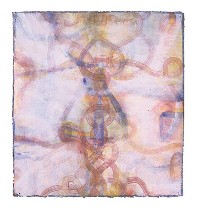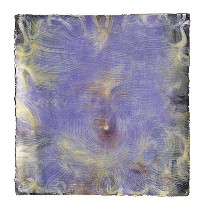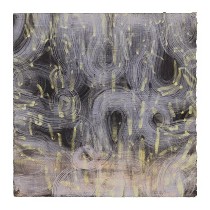
How sad, I thought, as I trudged through the icy, slushy streets, the wind driving the icy snow into my face. An artist has an opening on a night like this, the dough is spent on the reception, and no one comes.
And truly, when I arrived at Locks to see what artist Neysa Grassi was producing these days, the place was pretty empty, with maybe 10 people present.
But the work kept me engrossed for a good 45 minutes, by which time a crowd had gathered.
 The work, gouache on square or near-square paper, the largest about 15 inches square, some without much color, some glorious with colors, used a similar technique to her oils–layers and layers of paint screening and editing the lower layers like scrims or veils or thin skins, creating depth and interest without use of perspectival space.
The work, gouache on square or near-square paper, the largest about 15 inches square, some without much color, some glorious with colors, used a similar technique to her oils–layers and layers of paint screening and editing the lower layers like scrims or veils or thin skins, creating depth and interest without use of perspectival space.
Which brings me back to our discussion of abstract work. This work offers two key things–beauty and, as Roberta said, enough real-world illusion (landscape, body, etc.) from which to conjure a narrative, much like the way instrumental music suggests directions for imagination to let loose.
 I can see dark nights through windows, and church domes through veils of dust and history in this work. I see figures (even though I would bet figures were not on Grassi’s mind) and critters in dark, watery ponds. I see ornamental iron work and hair and ribs. And the longer I look, the more I see, as the lyrical surface paint gives way to the details of the deep reaches.
I can see dark nights through windows, and church domes through veils of dust and history in this work. I see figures (even though I would bet figures were not on Grassi’s mind) and critters in dark, watery ponds. I see ornamental iron work and hair and ribs. And the longer I look, the more I see, as the lyrical surface paint gives way to the details of the deep reaches.
These paintings may be about time–or not–but they require time and contemplation. I cannot say if they will survive time, but why not? Surely culture is not so dictatorial that only a Westerner familiar with our art traditions can find pleasure here.









